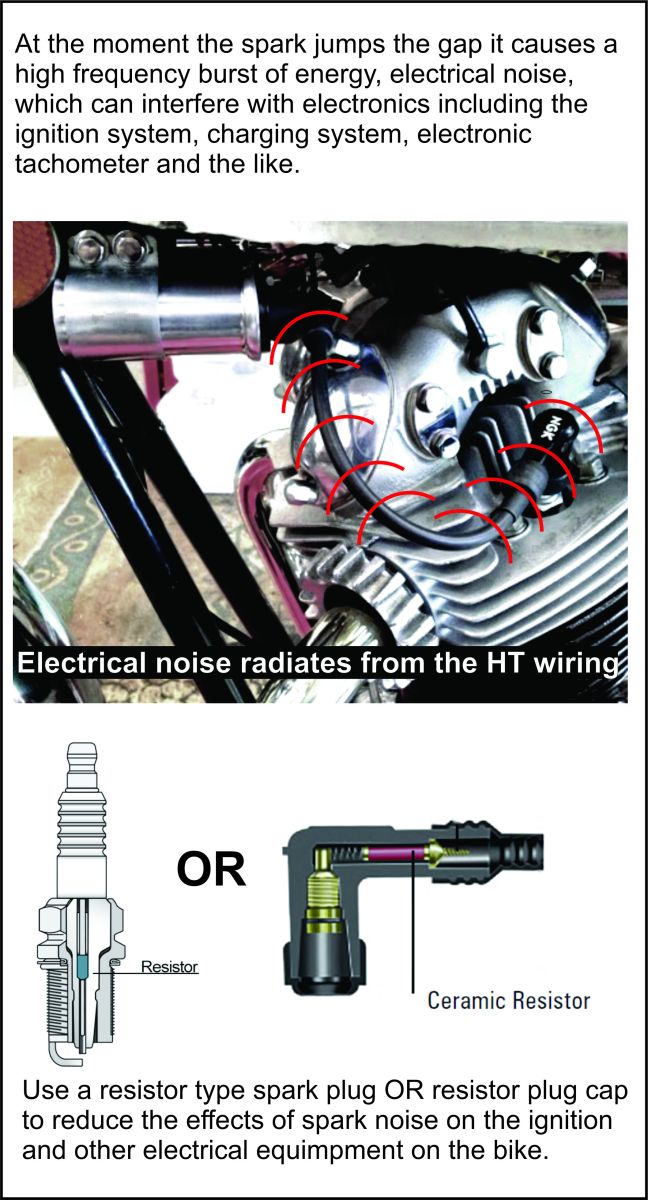Spark Plugs, Caps and HT Leads
Author: Tri-Spark Date Posted:30 August 2023
Having trouble with your electronic tachometer, or charging system or is the ignition misfiring? You may need to take a closer look at spark suppression.
We hear more questions about spark plugs and spark plug caps than anything else! Especially now that NGK has ceased production of their plug caps. When it comes to spark plugs and spark plug caps, it is important to consider spark suppression and the quality of the components for optimal performance. Spark suppression is necessary for engines with electronic ignition systems to reduce electrical noise that can interfere with various electronic components, including the ignition and charging systems.
For spark suppression, you have two options: resistor-type spark plugs or resistor-type spark plug caps. It is generally recommended to use either one OR the other, but not both together. Using both resistor-type spark plugs and caps together, leads to excessive spark suppression which can reduce ignition performance.
- Typical part numbers for resistor type spark plugs have an 'R' in the part number such as BR8ES. These should be used with non-resistor caps.
- Spark plug caps with '05' in the part number such as LB05EP have a 5k resistor built in and they should be used with non-resistor spark plugs such as B8ES.
- Most exotic spark plugs such as Iridium type BR8EIX have a 5k resistor built it which is denoted by the 'R' in the part number.
We generally encourage our customers to use the recommended spark plugs for their engine unless they have a particular reason to change such as racing. It is particularly important to match the heat range to the application.
A common question is 'do I need to open up the spark plug gap for electronic ignition'? We recommend a gap of 24 thou for most applications. A wider gap can worsen problems with plug fouling - a common trouble with older engines.
It is advisable to use high-quality spark plug caps that provide a tight seal and click securely onto the spark plug. The HT wire can be cut to the appropriate length and screwed into the terminal for easy connection to the cap.
When selecting HT leads (spark plug wires), it is recommended to choose good quality high-tension copper core leads specifically designed for motorcycles. HT leads designed for motorcycles typically feature a stranded copper core inside two layers of flexible silicone and rubber insulation. Carbon core leads suitable for cars may not perform well on bikes due to higher vibration and heat. Cutting carbon leads to length and fitting universal caps is generally not successful.
Using quality spark plug caps, spark plugs, and HT leads can help ensure proper ignition performance, reduce electrical noise, and contribute to smoother engine operation, while also minimising interference with electronic devices.
Comments (3)
1975 Triumph Trident
By: Dan Albert on 15 September 2023I have a tri spark ignition system and a lowbrow custom charging system. I am using NGK spark plug caps for a hotter spark. I a using BR 8ES NGK PLUGS. At idle it runs smooth from them on to about 45 it funs rough. Back fires through carbs and exhaust. From 45 on it runs strong. . Trying to find resister plugs is very hard.
Tri-Spark Response
As you have resistor spark plugs, it doesn't sound like that is the problem.
Spark plug
By: Peter Waugh on 30 August 2023Useful information thank you. Plug gap was useful for me. I run tri spark in a 1969 Triumph Trident.
Electronic tachos
By: Nick Coleman on 30 August 2023How and where to connect an electronic tachometer with a trispark ignition system on a Norton Dominator 88SS
Tri-Spark Response
Please refer to the tachometer instructions in the first instance. If it has an input for the ignition coil signal that would generally be connected to the negative side of the ignition coil. Each tachometer is different you will need to consider your particular installation when connecting the wiring.


